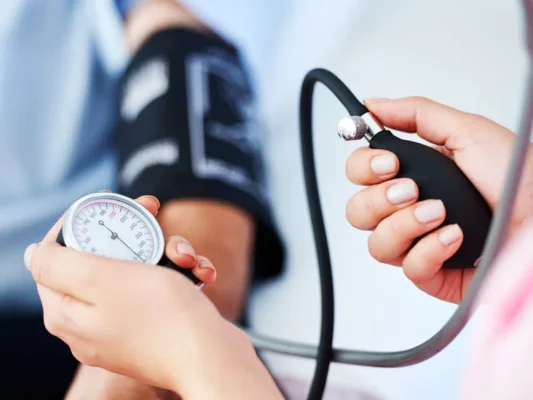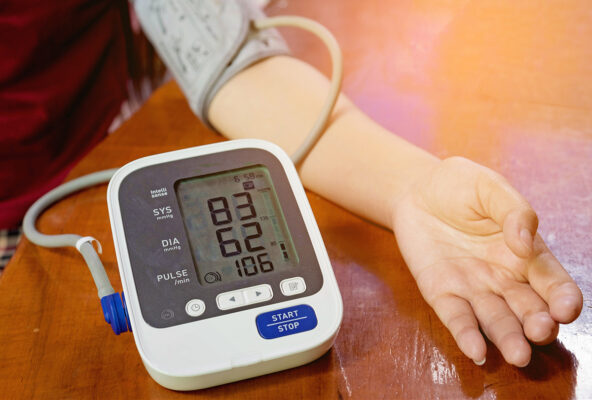BP Center
Disease name: Blood pressure
Introduction
High blood pressure is a common condition that affects the body’s arteries. It’s also called hypertension. If you have high blood pressure, the force of the blood pushing against the artery walls is consistently too high. The heart has to work harder to pump blood.
Blood pressure is measured in millimeters of mercury (mm Hg). In general, hypertension is a blood pressure reading of 130/80 mm Hg or higher.
Low blood pressure is generally considered a blood pressure reading lower than 90 millimeters of mercury (mm Hg) for the top number (systolic) or 60 mm Hg for the bottom number (diastolic).
The causes of low blood pressure range from dehydration to serious medical conditions. It’s important to find out what’s causing low blood pressure so that it can be treated, if necessary.

Methods used to test blood pressure:
1. Palpatory method

Palpatory method is the most commonly used method in wards and OPD but it has limitations of measuring systolic pressure only. Diastolic pressure is a very important part of blood pressure and the palpatory method is a very easy and quickest method for measuring blood pressure.
The Palpatory Method to Measure Diastolic Blood Pressure:
- Place the patient in a comfortable position, sitting or lying, with the forearm supported and the palm upward.
- Expose the arm for about five inches above the elbow. Remove any restrictive clothing from the arm.
- Place the center rubber bladder of the cuff over the brachial artery and wrap the cuff firmly and smoothly around the arm, one inch above the bend of the elbow (antecubital space). Position arm so cuff is at heart level.
- With the first three fingers, find the radial pulse.
- Inflate the cuff to about 30 mmHg above the pressure at which the pulse disappears.
- Keep your first three fingers of the nondominant hand lightly over the bend of the elbow at the medial side of antecubital fossa, so that the palmar surface of distal digits of these fingers make firm contact with antecubital fossa. Do not try to feel the pulse of the brachial artery.
- Deflate the cuff slowly.
- While deflating the cuff a pulsatile thrill can be palpated, the pressure at which thrill appears is a systolic pressure and, the disappearance of the thrill is the Diastolic Blood Pressure.
2. Auscultatory method

The Russian physician “Korotkoff” first described the auscultatory method in 1905. In this method the cuff is inflated to a level above arterial pressure (as indicated by obliteration of the pulse). As the cuff is gradually deflated, the pressure is noted at which sounds produced by the arterial pulse waves (Korotkoff sounds) appear and disappear again as flow through the artery resumes. The appearance of the first Korotkoff sound is the maximum pressure generated during each cardiac cycle: the systolic pressure. The level of pressure at which the sounds disappear permanently, when the artery is no longer compressed and blood flow is completely restored, is the resting pressure between cardiac contractions: the diastolic pressure.” As the pressure is reduced during deflation of the occluding cuff, the Korotkoff sounds change in quality and intensity.
The five phases of this change are characterized as follows:
Phase 1: First appearance of clear, repetitive, tapping sounds. This coincides approximately with the reappearance of a palpable pulse.
Phase 2: Sounds are softer and longer, with the quality of an intermittent murmur.
Phase 3: Sounds again become crisper and louder.
Phase 4: Sounds are muffled, less distinct, and softer.
Phase 5: Sounds disappear completely.
3. Oscillometric Method

Most automatic cuff blood pressure (BP) measurement devices are based on oscillometry. These devices estimate BP from the envelopes of the cuff pressure oscillations using fixed ratios. The values of the fixed ratios represent population averages, so the devices may only be accurate in subjects with normal BP levels. The objective was to develop and demonstrate the validity of a patient-specific oscillometric BP measurement method.
Advantages and Pitfalls of the Oscillometric Method
There are many oscillometric NIBP devices on the market today. They range from expensive, rugged instruments for clinical use to miniaturized units that fit on a wrist. Most of these devices use continuous linear or nonlinear deflation methods. Some devices use a step-deflation method, and some recent monitors use an inflation method. Ease of use has made oscillometric devices very popular. The elimination of external sensors contributed to their popularity at the price of increased uncertainty in the determination of SBP and DBP.
4. Pulse wave velocity (PWV)

Pwv is the velocity at which the blood pressure pulse propagates through the circulatory system, usually an artery or a combined length of arteries.[1] PWV is used clinically as a measure of arterial stiffness and can be readily measured non-invasively in humans, with measurement of carotid to femoral PWV (CFPWV) being the recommended method of PWV is highly reproducible, and predicts future cardiovascular events and all-cause mortality independent of conventional cardiovascular risk factors. It has been recognized by the European Society of Hypertension as an indicator of target organ damage and a useful additional test in the investigation of hypertension.
Pulse-wave velocity (PWV) is a measurement of arterial stiffness that is an independent predictor of cardiovascular risk. It can be measured simply and noninvasively by measuring the carotid and femoral pulse pressures and the time delay between the two or by other methods relying on pulse-wave analysis. Direct measurement of aortic compliance is possible by magnetic resonance imaging
Medical treatments for blood pressure:
Medicines used to treat high blood pressure include:
1. Water pills (diuretics):
These drugs help remove sodium and water from the body. They are often the first medicines used to treat high blood pressure.
There are different classes of diuretics, including thiazide, loop and potassium sparing. Which one your provider recommends depends on your blood pressure measurements and other health conditions, such as kidney disease or heart failure. Diuretics commonly used to treat blood pressure include chlorthalidone, hydrochlorothiazide (Microzide) and others.
A common side effect of diuretics
Increased urination. Urinating a lot can reduce potassium levels. A good balance of potassium is necessary to help the heart beat correctly.
- Examples of thiazide diuretics include:
chlorthalidone (Hygroton),chlorothiazide (Diuril),hydrochlorothiazide (Hydrodiuril, Microzide),indapamide (Lozol),metolazone (Zaroxolyn)
- Examples of potassium-sparing diuretics include:
amiloride (Midamor),spironolactone (Aldactone),triamterene (Dyrenium)
- Examples of loop diuretics include:
bumetanide (Bumex),furosemide (Lasix),torsemide (Demadex)
2. Angiotensin-converting enzyme (ACE) inhibitors.
These drugs help relax blood vessels. They block the formation of a natural chemical that narrows blood vessels. Examples include lisinopril (Prinivil, Zestril), benazepril (Lotensin), captopril and others.
3. Angiotensin II receptor blockers (ARBs).
These drugs also relax blood vessels. They block the action, not the formation, of a natural chemical that narrows blood vessels. ARBs include candesartan (Atacand), losartan (Cozaar) and others.
Examples of ARBs include:
- candesartan (Atacand)
- eprosartan (Teveten)
- irbesartan (Avapro)
4. Calcium channel blockers.
These drugs help relax the muscles of the blood vessels. Some slow your heart rate. They include amlodipine (Norvasc), diltiazem (Cardizem, Tiazac, others) and others. Calcium channel blockers may work better for older people and Black people than do ACE inhibitors alone.
Don’t eat or drink grapefruit products when taking calcium channel blockers. Grapefruit increases blood levels of certain calcium channel blockers, which can be dangerous. Talk to your provider or pharmacist if you’re concerned about interactions.
Examples of these drugs include:
- amlodipine (Norvasc, Lotrel), diltiazem (Cardizem CD,
- Cardizem SR, Dilacor XR, Tiazac), felodipine (Plendil),
- isradipine (DynaCirc, DynaCirc CR), nicardipine (Cardene SR)
5. Alpha-blockers
In certain situations, your body makes hormones called catecholamines. These hormones can bind to parts of cells called alpha-receptors. When this occurs, your blood vessels narrow and your heart beats faster and with more force. These actions cause your blood pressure to rise.
Alpha-blockers work by blocking catecholamines from binding to alpha-receptors. As a result, blood can flow through the blood vessels more freely, and your heart beats normally. This helps lower your blood pressure.
Examples of alpha-blockers include:
- doxazosin (Cardura)
- prazosin (Minipress)
- terazosin (Hytrin)
Medicines used to treat low blood pressure include
Fludrocortisone is a medication that seems to help some types of low blood pressure. It works by promoting sodium retention by the kidney, thereby causing fluid retention and some swelling, which is necessary to improve blood pressure. But this sodium retention also causes a loss of potassium. So when taking fludrocortisone, it’s important to get enough potassium each day. Fludrocortisone has none of the anti-inflammatory properties of cortisone or prednisone and does not build muscle like anabolic steroids.
Midodrine activates receptors on the smallest arteries and veins to produce an increase in blood pressure. It is used to help increase standing blood pressure in people with postural hypotension related to nervous system dysfunction.
BP CLINICS PACKAGES:

Cost:
Generally, Ambulatory Bp Monitoring Abpm cost in India for Indian Patients is between Rs.8347 to Rs.11130. Cost for International patients is between USD 169 to USD 207.The total cost of the treatment depends on the diagnosis and facilities opted by the patient.



